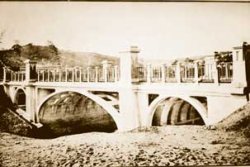
"POLYTECHNICA" magazine 31/32, 19101910: 28-meter long bridge in Socorro, over the Machados brook"POLYTECHNICA" magazine 31/32, 1910
In the second half of the 19th century, up until 1910, the port of Santos, on the coast of the state of São Paulo, was considered by the Europeans as ‘accursed’. There was no lack of reasons. The city was flat, swampy, hot, polluted and with a growing population of immigrants – because of the exportation of coffee – and it collected epidemics: yellow fever, malaria, bubonic plague, smallpox and tuberculosis. To save the health of the inhabitants of Santos and the local economy, all that remained was to clean up the city at any cost. An engineer from the state of Rio de Janeiro, Francisco Saturnino Rodrigues de Brito, was chosen for the Cleaning Up Commission, and São Paulo physician Guilherme Álvaro for the Sanitary Commission. Reinforced concrete, a building technique already used abroad, but practically unprecedented in Brazil, played an important part in the restoration of Santos’s salubrity.
As far as the studies of the specialists in engineering and history go, the first works known to have been made with this technique were the channels, sewers and bridges that crisscross Santos, designed and constructed by Saturnino de Brito. He imagined that the channels would drain off the rainwater and take up the water that came from the hills. A system of sluice gates would regulate the entry and exit of water to the sea. Besides this, the tides would act on the channels, stopping the water from becoming stagnant and preventing mosquitoes. Channel 1, made over the course of the Soldados brook, was inaugurated in 1907. In all, Brito designed eight of them, to which another was added later. The work was fundamental for cleaning up the city and became the city’s trademark, together with its extensive seaside gardens. Next year, the hundred years of the channels will be celebrated, under the responsibility of an organizing committee, taking part in which is the Santos Archives and Memory Foundation (www.fundasantos.org.br).
Reinforced concrete is a mixture made up of cement, sand, water and stones, which covers the ironwork and takes on any shape that is wanted. It arose in France, with Joseph Louis Lambot, in 1850. In Brazil, the first reference there is to the technique came from Professor Antonio de Paula Freitas, from the Polytechnic School of Rio de Janeiro. In a work of 1904, Freitas mentions the construction of six buildings designed by the engineer Carlos Poma, who was also said to have constructed a reservoir in Petrópolis, in Rio. It so happens that to that, today, there is no sign of where these constructions were built, and no there are no known vestiges of them. “Nor can one say that they were of what today is defined as reinforced concrete”, says Augusto Carlos de Vasconcelos, an engineer and retired professor from the Polytechnic School of the University of São Paulo and from Mackenzie University, the author of the study “Major works in reinforced concrete“, which is to be found in the book ‘500 Years of Engineering in Brazil’ (Edusp, 384 pages).
After the channels of Santos, Vasconcelos believes that the bridge over the Machados brook, in Socorro (SP), is the oldest known work in Brazil to use the technique, in 1910. “Reinforced concrete set off a revolution in Brazilian engineering, because with metallic structures alone, there would be no conditions for making so many major works”, the engineer explains. “Steel was imported, expensive, and there was no industry installed to produce it here.” Another factor contributed towards its dissemination: unskilled workers learn to make the mixture easily on the ground of the building site and to apply it to the ironwork. This ideal environment found in Oscar Niemeyer its best architect. “It’s no exaggeration to say that Niemeyer wouldn’t be Niemeyer without reinforced concrete”, he says.
On the subject of his work with the technique, Niemeyer has already said the following: “I have pored over architecture all my life. It was my hobby, one of my joys, to look for the new and creative shape that reinforced concrete suggests. To discover it, to multiply it, to insert it into the most advanced technique, to create the architectural spectacle”.
Republish